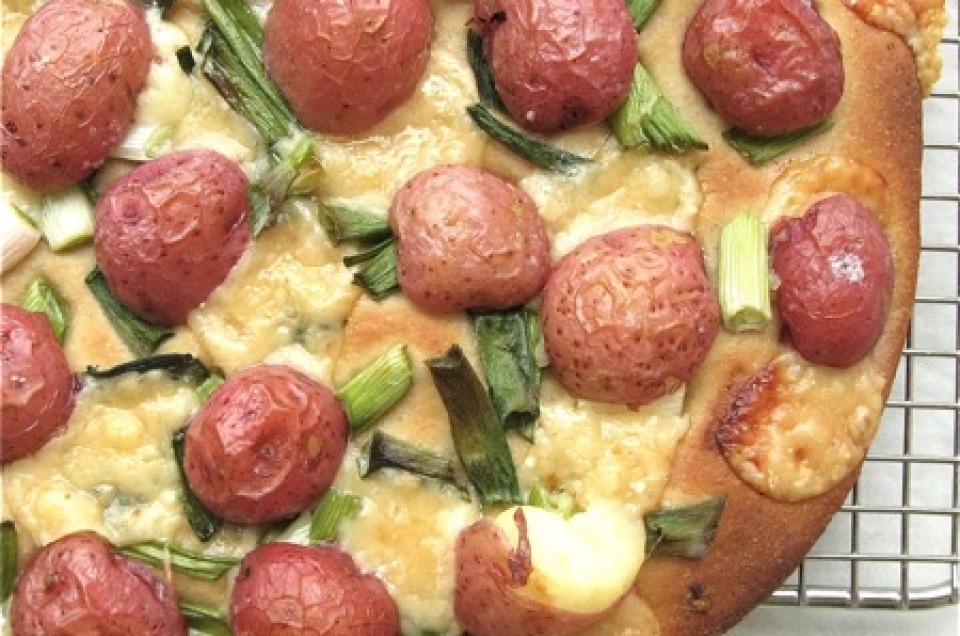


Now I ask you, does this look like a pizza that would elicit doubt? Not just doubt, but apprehension.
To say nothing of puzzlement.
Yea, even a touch of "Ewwwww."
That's just how my Web teammates greeted this pizza when I brought it, hot from the oven, into our office for a birthday lunch a few weeks ago.
"What IS that on top? That's not potatoes, is it?"
"Yes," I replied, "Those are most certainly potatoes, and they are indeed on top of this pizza. Along with chopped scallions and melted chunks of Asiago cheese. Ya got a problem with that?"
Eyebrows arched. Mouths downturned. I could read it all on their faces.
"We've been looking forward to pizza and she made it with POTATOES? Isn't that kinda weird, like, carbs on carbs?"
Sigh. Webbies, where's your sense of adventure? (Wo)man does not live by pepperoni and mozzarella alone.
"C'mon, guys. Just try it. Forget what it sounds like; concentrate on the taste."
And, since there was nothing else for lunch besides salad and chips and Diet Pepsi – they did.
I tell you, it was like a revival meeting - they suddenly saw the light.
"Hey – this is GOOD. Like, REALLY good. Potatoes on pizza – who knew?!"
I knew. I bent my head to cover a self-satisfied smirk. There's absolutely nothing not to like about hot, buttery roasted potatoes. And onions. And melting cheese. Especially when it's all on top of a crisp-chewy, whole wheat crust absolutely packed with vitamins, minerals, antioxidants – and flavor.
Speaking of antioxidants, researchers at the University of Maryland published a study several years ago showing that pizza crust made with whole wheat flour, when allowed to rise overnight and bake in a very hot oven for a relatively long time, is better for your health than a standard pizza crust.
Why? Antioxidants, the nutritional substance in certain foods (including whole wheat flour), counteract the harmful effects of oxidation on your system. Research shows antioxidants may help prevent diseases such as heart disease, Alzheimer's, stroke, and cancer, among others.
So, we already know whole wheat flour is more nutritious than "white" flour; why not up the ante even more, and take full advantage of its health attributes?
Besides, this whole wheat pizza crust is just plain tasty.
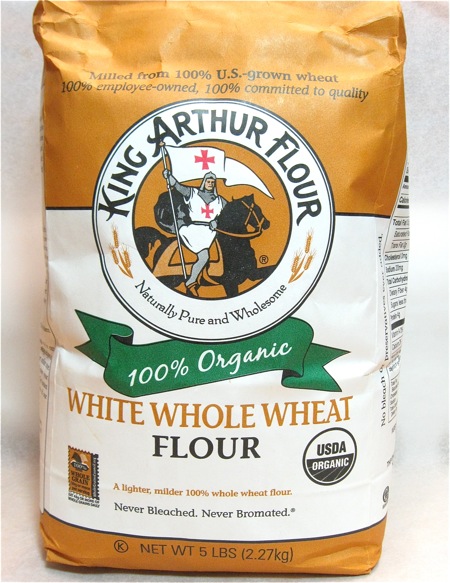
Here's my top choice when I reach for whole wheat flour: our organic white whole wheat.
Organic, because it seems to rise better in yeast breads (maybe the yeast responds to the way the wheat was grown?)
White wheat, rather than traditional red wheat, because I prefer the milder flavor and lighter color.
Let's get started.
Here's a scheduling tip: Since this dough has to chill overnight, make it at 8 p.m., and refrigerate until 4 p.m. the next day. Shape, let rise for 2 hours, and bake at 6 p.m. – just in time for dinner.

Place the following in a mixing bowl:
3 cups (340g) King Arthur White Whole Wheat Flour or King Arthur 100% Organic White Whole Wheat Flour*
2 teaspoons instant yeast
1 1/4 teaspoons salt
2 tablespoons (43g) honey
2 tablespoons (28g) orange juice, lukewarm
2 tablespoons (25g) olive oil
3/4 cup to 7/8 cup (170g to 198g) lukewarm water
*Can you use traditional red wheat flour in this recipe? Absolutely; your crust will be darker, and more assertively flavored due to red wheat's stronger taste.
Oh, and by the way, what's with the orange juice? No, it doesn't make your pizza taste like oranges; but it does mitigate the somewhat tannic flavor whole wheat can sometimes have. Substitute water if desired.

Combine all of the ingredients, and allow to rest, covered, for 30 minutes; this gives the whole wheat flour a chance to absorb the liquid.

Mix and knead to make a smooth, fairly soft dough; it probably won't be sticky enough to cling to the sides of the bowl, but if it is, no worries – the overnight chill will take care of any stickiness.

Transfer the dough to a bowl or 8-cup measure, cover it, and let it rest at room temperature for 30 minutes.
Refrigerate overnight, or for about 18 hours; a bit longer is fine.
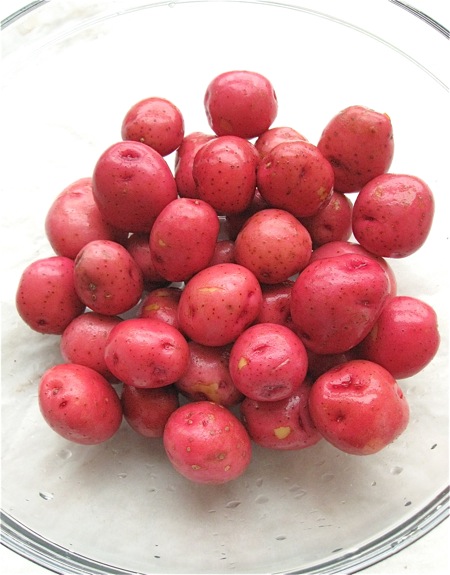
Feel free to use any of your favorite toppings on this crust - especially if you're of the "ewww, potatoes on pizza" school of gourmanderie. But if you're willing to give potato pizza a try, here's how.
Prepare the potatoes while the dough is chilling, or anytime before it's ready to be topped. I love tiny new red potatoes; I found 1 3/4 pounds, about 35 small potatoes, is perfect for this pizza – and won't drain your wallet too heavily.
Wash the potatoes, and put them in a microwave-safe bowl. Microwave for 10 to 12 minutes, covered, until they're soft but not collapsing; "al dente," as it were.
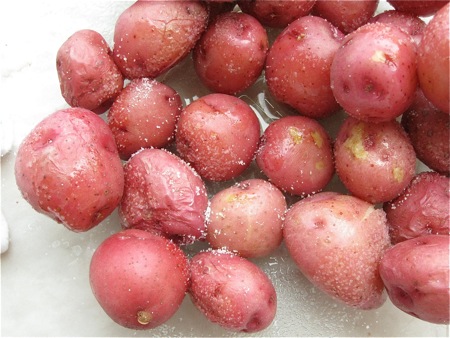
Toss the potatoes with a bit of olive oil, and sprinkle heavily with salt.
Or not; your choice. I happen to like salty potatoes.
Set them aside until you're ready to top the pizza.

Remove the dough from the fridge. For 100% whole wheat dough, that's a nice rise, isn't it?

Pat the dough into a lightly greased half-sheet pan (18" x 13") that's been drizzled with olive oil. This will make a medium-crust, Sicilian-style pizza, one that's thick enough to undergo the long bake at a high temperature necessary to optimize its antioxidants.

The dough will probably fight back as you try to pat it to the edges of the pan. Don't engage in the battle; discretion is the better part of valor. Walk away for 10 to 15 minutes, then come back and pat some more.
This short rest gives the gluten a chance to relax; you'll be amazed how cooperative the dough has become! If necessary, give it another rest before patting just about to the pan's edges – as pictured above.

Clean 2 bunches of scallions, and chop in 1" to 2" pieces, both white and green parts. Spread them over the crust.

Cut 6 ounces of Asiago or Parmesan (or Romano, or your favorite sharp cheese) into chunks. Spread them over the crust.

Finally, halve the cooked potatoes, and spread them over the crust, cut side down.
Cover the pizza, and let it rise for about 2 hours, or until it's very puffy. Towards the end of the rising time, preheat the oven to 450°F.

Researchers managed to increase antioxidants to their highest level by baking pizza crust at 500°F. However, since some readers have ovens that won't heat that hot; and since baking at 500°F can be a little tricky (the time difference between perfect and burned becomes very short), we've chosen a slightly more moderate baking temperature: 450°F.
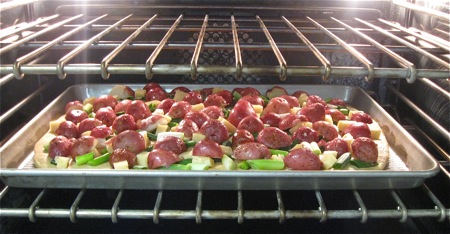
Bake the pizza on the bottom shelf of the oven for 8 minutes, then transfer it to a shelf in the upper third of the oven. Bake for an additional 6 to 8 minutes, until the cheese is melted and the crust browned.

Like this. Perfect!
Remove the pizza from the oven, let it rest for about 5 minutes (for the cheese to settle), and serve it right away.

Here's one more look at not only the potatoes, cheese, and scallions; but that nicely risen, tasty, nutritious 100% whole wheat crust.
As I said, if potatoes don't float your boat, substitute your favorite toppings. If you're going with shredded cheese, I'd suggest baking the pizza on the bottom rack of the oven without its cheese; then adding the cheese just before transferring to the top rack. This will keep the cheese from burning and/or becoming rubbery and overcooked.
Read, bake, and review (please) our recipe for A Tasty Whole-Grain Pizza Crust.